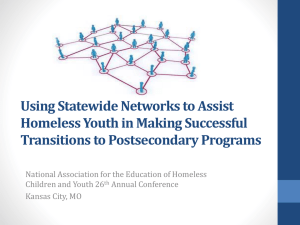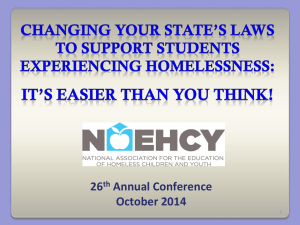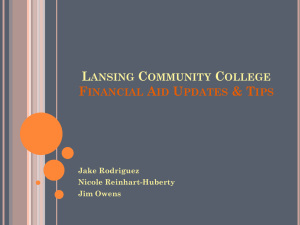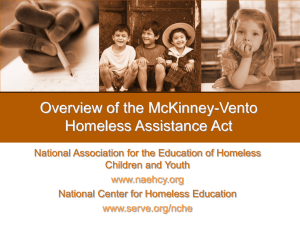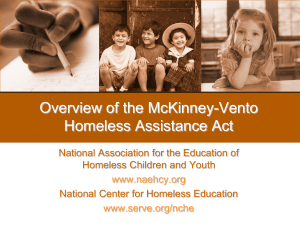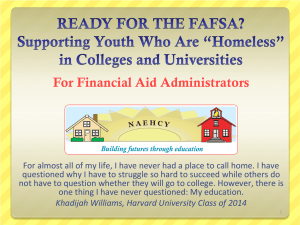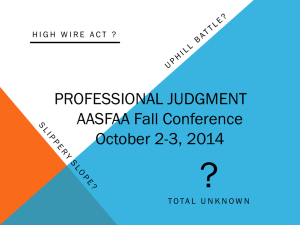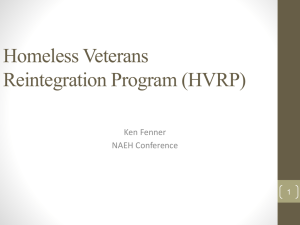Using Statewide Networks to Assist Homeless Youth in Making
advertisement
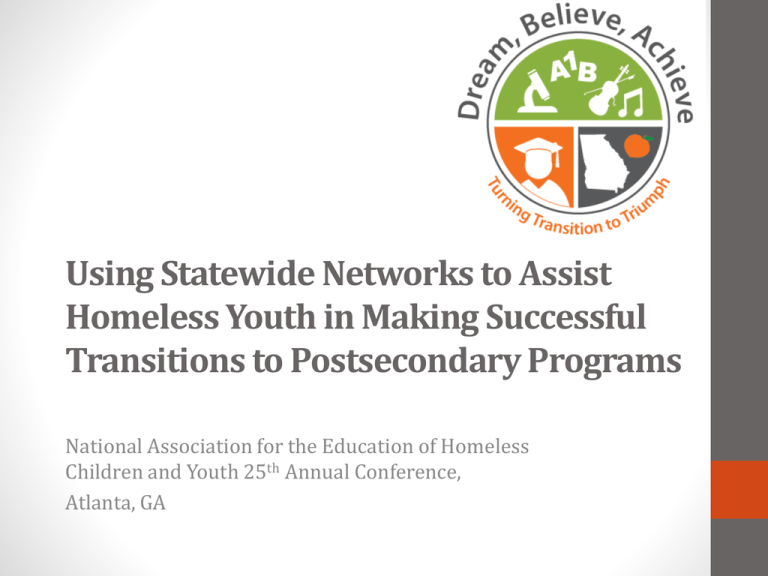
Using Statewide Networks to Assist Homeless Youth in Making Successful Transitions to Postsecondary Programs National Association for the Education of Homeless Children and Youth 25th Annual Conference, Atlanta, GA Presenters • Shirley Fan-Chan, • Director U-ACCESS • University of Massachusetts Boston • http://www.umb.edu/life_on_campus/uaccess • Joan Meschino • Executive Director • MA Appleseed Center • www.massappleseed.org Presenters • Pamela K. Kies-Lowe • Homeless Education Consultant/State Coordinator for Homeless Education • Michigan Department of Education • www.michigan.gov/homeless • Cyekeia Lee • National Higher Education Liaison for Homeless Youth • National Association for the Education of Homeless Children and Youth (NAEHCY) • www.naehcy.org Agenda • Define Statewide Networks • Goals & Roles for Statewide Network • Statewide Network Model • Overview of SPOC’s • Best Practices: Colorado Network • New Statewide Networks • Panel Discussion • Questions What are Statewide Networks for Homeless Youth? • People and organizations working together to help homeless students access and complete postsecondary programs • Often include one or more McKinney-Vento and Higher Education Champions to cross train • Includes Stakeholders from K-12 education, Local homeless liaisons, higher education staff, RHYA and HUD shelter staff, and college access program staff Why are Statewide Networks Needed? • Last year 58,158 youth indicated on the FAFSA that they were unaccompanied homeless youth • Many of the these youth need additional assistance navigating higher education systems What Barriers do Statewide Networks Address? • Entrance requirements • Financial aid eligibility/packages • Housing • Understanding of homelessness • On-campus support • Academic offerings and supports • Supportive off-campus communities Roles and Responsibilities of Statewide Networks • Define roles and responsibilities for champions, taskforce, and SPOC’s • Discuss communication (email, webex meeting, conference call, in person, newsletter) • Discuss how often you will meet as a group • At least one in person meeting per year • Get data for population you are serving • How many youth? Retention? Graduation? • Develop one year plan of taskforce work Create SPOC’s on Campuses • A Single Point of Contact or (SPOC) is a safe and supportive college administrator who is committed to helping unaccompanied homeless youth successfully navigate the college-going process • SPOC’s also identify offices that unaccompanied homeless youth can go to for additional campus services Network Model Step 1 Identify Champions Step 2 Conduct Focus Group Step 3 Develop Task Force • Identify MV Champion • Identify HE Champion • Define purpose • Identify Stakeholders • Discuss Network Goals • Assess Needs of Homeless Youth Network Model Step 4 Train Task Force Step 5 Identify Single Points of Contact s Step 6 Get NAEHCY Support • Use NAEHCY & NCHE Training Materials for trainings • Identify SPOC’s at each institution • Conduct SPOC Training • Contact NAECHY Higher Ed. Liaison • Use NAEHCY/NCHE web resources Best Practices: Colorado Network Consists of stakeholders from: Colorado Department of Education,K-12 McKinney-Vento Liaisons , Higher Education personnel from Financial Aid, Admissions, and Student Support Services • Collaborates to streamline the verification process between K-12 and higher education • Has established Single Points of Contact (SPOCS) in all CO colleges/universities to help eliminate barriers to higher education access Best Practices: Colorado Network • Barriers addressed included waiving application fees, deferring housing deposits, and connecting students with community resources • In 2011 the Colorado taskforce along with the nonprofit Family Tree established private funding to assist UHY • Meet three times a year, and conducts individual SPOC training at each college Existing Statewide Networks Colorado*, North Carolina*, Kentucky, New Hampshire • Have identified champions • Created Taskforce • *Has established SPOC’s at each institution in state • Meets regularly to discuss new initiatives for network • New Network States • Michigan, Florida, Georgia, Illinois, Oklahoma, Massachusetts • Identifying MV/HE Champions • Assessing needs of youth in area • Identifying taskforce members • TRIO, GEAR-UP, NCAN, NACAC, NASFAA • Gathering training material from NAEHCY/NCHE Panel Discussion Resources from NAEHCY • NAEHCY Toolkit: College Access and Success for Students Experiencing Homelessness available at http://www.naehcy.org/educational-resources/hetoolkit • NAEHCY Higher Education Helpline (855) 446-2673 (toll-free) highered@naehcy.org http://www.naehcy.org/educationalresources/helpline • FAFSA Tips for Unaccompanied Youth Without Stable Housing and Helping Unaccompanied Homeless Youth Access College Financial Aid at http://www.naehcy.org/educationalresources/higher-ed Resources from NCHE • Helpline: 800-308-2145 or homeless@serve.org • Website: http://center.serve.org/nche Access to Higher Education for Students Experiencing Homelessness http://center.serve.org/nche/ibt/higher_ed.php Scholarships http://center.serve.org/nche/ibt/scholarships.php Sample Forms and Materials http://center.serve.org/nche/forum/higher_ed.php Questions? Cyekeia Lee National Higher Education Liaison for Youth clee@naehcy.org, 734-258-8175 Website www.naehcy.org NAEHCY Helpline, 855-446-2673 highered@naehcy.org
